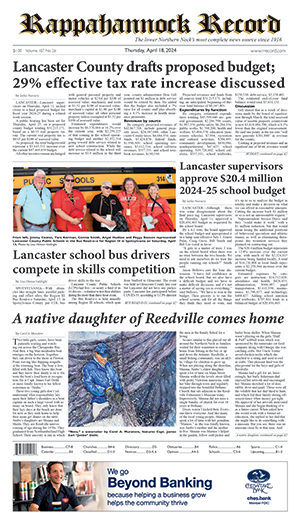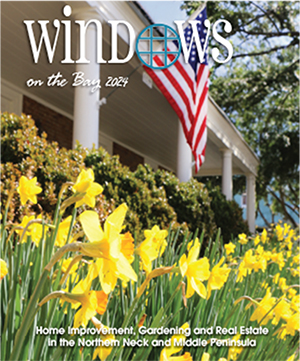by Denise DeVries
James Wharton filmed Northern Neck people at work and play in the 1920s and 1930s, and especially at play. From water-skiing to crabbing, zip-lines to skinny-dipping, horseplay on the playground to music at the schools, Wharton captured images of everyday enjoyment.
While Irma Burke remembers James Wharton mostly for his piano playing, his films also remind her of great times outdoors, on the river and ashore. Born Irma Pauline Henderson in 1915, she was part of a large family living on Mosquito Point Road. Her mother, Catherine Brent Lawson, was born in 1894 in White Stone, and her father, Leslie Pascal Henderson, was born in Palmer in 1887.
Irma was the third child, after Augusta and Orville and before Gwendolyn, Vergil and Celeste. The Henderson home was originally part of Lawson Bay farm, owned by the Lawsons since the 1600s. Burke’s aunt, Kate Lawson Payne, bought the property from a Mr. Hughlett, who had married Maggie Lawson. A cove behind the house provided cool fun on hot days and occasional skating in the winter.
Like many families in the Northern Neck, the Hendersons were self-sufficient. Mr. Henderson was a fisherman and would follow the fish up and down the coast. Mrs. Henderson took care of the garden and raised cows, horses and pigs. She made clothes for all the children using a Singer treadle machine that her granddaughter, Catharine Moore, still has in her home.
When the Wards and Sears catalogs arrived in the mail, the children looked through them to choose the clothing they liked. Mrs. Henderson made her own patterns based on the catalog pictures.
During World War II, Burke and her mother learned to knit from a book so that they could provide items such as socks for the soldiers.
By the time Burke was born, many businesses and some homes in the Northern Neck had electricity. When the Hendersons built their new house, the original plan was to put in a windmill to run the pump. However, Mrs. Henderson’s first cousin, Tell Lawson, who worked for Delco, convinced them to use a Delco motor. This charged 24 batteries of 32 volts each, which were kept in the basement. They powered the lights and the pump, which provided water for the house and livestock. While the Hendersons had electricity whenever they needed it, homes in town only received electric service until 11 p.m.
Before refrigerators were common in homes, trucks would bring ice from the Little Bay Ice Plant on Antipoison Creek. The large ice slabs were placed in an icebox and as they melted, the water went into a container that had to be emptied to avoid overflows. An ice pick was used to chip off bits of ice for drinks or for making ice cream.
Burke recalls colder winters than we experience today, with snow-covered dirt roads and frozen ponds. Sometimes even the river would freeze; their cove offered safe skating as long as they stayed away from the end where the tide came in from the river. People also gathered for ice-skating on Norris’s Pond outside of Kilmarnock. Burke’s mother would make snow (ice) cream with the second snowfall, since the first snow was considered too dirty to eat. The family’s cows provided the cream and preserved fruits from the garden offered a variety of flavors.
The family also enjoyed ice cream in the summer, with the children taking turns cranking the machine and “checking” the consistency of the ice cream on the dash, the blade that churned the liquid. The children worked in the garden on summer mornings. When it started getting hot, they could play in the cove. Later in the day, they would go to the river to swim, as long as there were not too many big sea nettles. Burke recalls that they seemed as big as a child’s head and sometimes groups of them were all tangled together. White Stone Beach kept the sea nettles out with a net around the swimming area.
Burke remembered that biplanes flew over occasionally and they were such a novelty that everyone would run outside to take a look. During the Depression, Burke often saw cars stopping to pick up passengers on the roadside. Those early hitchhikers would hop onto the running boards along the sides of the car and hold on to the top until they reached their destination.
Mrs. Burke met her husband, Wade Raleigh “Tater” Burke, when she was working at Peoples Bank of White Stone. She started at the bank in January 1933, having graduated from high school at the age of 16. She worked until her retirement from Bank of Virginia 44 years later, only taking off four years when their daughter Catharine was born.
Burke remembers the banks closing in 1933 when Roosevelt was inaugurated and all of the banks had to be audited. Because the bank where she worked was a state rather than national bank, the process went faster and they could open sooner.
There seemed to be few effects of the Depression in the Northern Neck, she said. Most people had gardens and some had livestock. Burke recalls that Works Progress Administration (WPA) workers came to White Stone and there were Civil Works Administration (CWA) camps for younger workers. These job creation groups were established by the government to deal with the high unemployment rate at the time.
Mr. Burke was working at the White Stone ESSO gas station, which he later purchased from the owner, Harmon Treakle. Mr. and Mrs. Burke were married in 1936. When asked if she called her husband “Tater,” she answered, “I always called him Burke.”
Wade Raleigh Burke was born in 1914. His mother was from Essex County and his father was from Fredericksburg. He was the fourth child in his family, after Leah, Willard and Lewis and before Della, Hyacinth and Irwin.
Northern Neck weather seemed more extreme in all seasons compared to today. In the Great Storm of 1933, high water washed out docks, covered roads and left people stranded.
Mrs. Burke borrowed a car and first picked up her sister Gwen, who was working for the Culvers at White Stone Beach. She walked up the hill with her suitcase on her head. When Burke returned to the bank, her brother-in-law J.P. Dize called her and asked her to pick him up. She took him as far as the car could go on the flooded road and he walked the rest of the way home.
The Northern Neck once had various types of entertainment no longer available. In addition to some of the events and entertainment depicted in Wharton’s films, Burke recalls there was a track for sulky harness racing. For day trips to Richmond, ferries ran from Irvington to Urbanna. They were owned first by the Garrett brothers, later by John Q. Adams and finally the state took them over.
Kilmarnock had a hotel, where Wharton’s Northern Neck Movies were shown. Irvington also had the “Beach Hotel.” Steamboats that docked at the end of Steamboat Road in Irvington included the James Adams Floating Theater, where Burke once saw a variety show.
Churches were important meeting places in the community. Mr. and Mrs. Henderson were Methodists and the whole family rode to the Methodist Church when Mr. Henderson was home. When he was out on the fishing boat and Mrs. Henderson had young children at home, the older ones would walk to the nearby White Stone Baptist Church where their maternal great-grandmother was a charter member.
After she retired from working as a bookkeeper at the bank, Burke was a volunteer at the hospital for 27 years. When the bank was torn down, the tellers and Burke were given their marble counters. Her counter is now the top of a table near her window at Rappahannock Westminster-Canterbury, where she has lived for 13 years. Burke enjoys gardening and reading. She will be 102 years old in September of this year.











